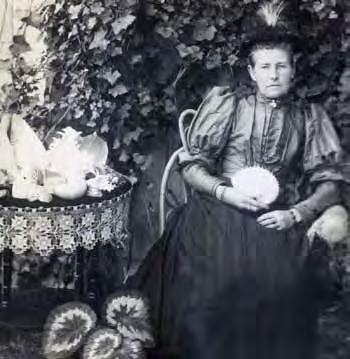
3 minute read
Double delivery Kate Murray is producing a book of Museum tales and treasures by Brendan Atkins
JAnIe’slegacyDo we acquire our passions anD interests from our parents? MICHAEL WATERHOUSE traces his family’s achievements in science back to his great-granDmother, Janie.
On a cool July morning in 1895, an observer would have noted a curious group at Little Manly Cove, peering into pools and turning over rocks on tidal flats. The group – Janie (Mary Jane) Waterhouse and her three sons Athol, Gowrie and Leslie – was making another of its frequent visits to Little Manly to collect cowry shells. Janie Waterhouse (1853–1935) had been collecting shells for some years. Though lacking formal scientific training, she attached great importance to taxonomy – the classification of species – and meticulously recorded all discoveries in her diary. In August 1895, exactly one hundred of Janie’s specimens, belonging to 17 species of cowry, were displayed at the Linnean Society of NSW, including 11 species not previously recorded from Sydney Harbour. Over many years, Janie assembled a shell collection remarkable for its size and diversity. It included spectacular specimens acquired from all over the world, with many brought back by her husband, Gus, from his frequent trading trips to the Pacific. In 1930, she donated her collection to the Australian Museum. But however valuable her donation, Janie left another legacy to future generations. Her innate curiosity about the natural world instilled in her children a strong spirit of inquiry and love of natural history.
BUTTERFLIES AND BEETLES
Janie’s eldest son Athol (1877–1950) attended Sydney Grammar and reportedly spent much time with his brothers browsing in the adjacent Australian Museum. Though he worked at the Royal Mint as assistant assayer from 1900, his real love was butterflies. He’d begun collecting them as a boy and over many years undertook extensive taxonomic research, resulting in more than 50 scientific papers. He co-authored the groundbreaking book Butterflies of Australia with George Lyell in 1914 and in 1932 wrote a further volume, What Butterfly is That?, with illustrations by Neville Cayley. Among his many scientific affiliations, Athol was an honorary entomologist at the Museum and became a Trustee in 1927, even serving briefly as President in 1930. He donated much of his butterfly collection and library to the Museum. As Janie had taken her children cowry collecting, so years later Athol took his nephew Douglas on butterfly collecting trips around Sydney, stimulating his interest in these and other insects. Douglas went on to become Chief of the Division of Entomology at CSIRO in Canberra where he did much to promote the importance of collecting and studying insects. He is remembered among many achievements for his role in introducing dung beetles to Australia and inventing Aerogard insect repellent. Doug was elected a Fellow of the Royal Society in 1967 for his contribution to science.
CAMELLIAS
Janie’s second son Gowrie (1881–1977) was to become a professor of German at the University of Sydney. Also fluent in French and Italian, he did much to promote the literature and culture of all three countries. His other love was horticulture, and he became a leading authority on camellias. His home, Eryldene, in Gordon is now an historic house and garden attracting thousands of visitors annually. Leslie (1886–1945), a mining engineer, made his name in New Guinea overseeing one of the largest gold mining operations in Australasia. Like his brothers, Leslie had a private passion: photography, in which he took an active interest from an early age. The photos and film footage he took in New Guinea are today in public collections. Janie’s legacy is thus a remarkable one, with her three sons and grandson Douglas in particular making their mark in several fields of natural history. The circle that began with the donation of Janie’s shells to the Museum has closed with one of Janie’s greatgrandchildren – Doug Waterhouse’s niece Janet – working in the Museum as a Technical Officer. Her field of interest? Malacology, the study of molluscs, the phylum which includes cowries.
MichAel WAterhouse historian
WEBLINK
identify any nsw seashell online at seashellsofnsw.org.au
Left
Janie Waterhouse with her shell collection in 1895. Photo courtesy Michael Waterhouse.
Below
the Museum’s Janet Waterhouse with sydney harbour cowries and a diary holding collection data, donated by her great-grandmother. Photo by Carl Bento.


